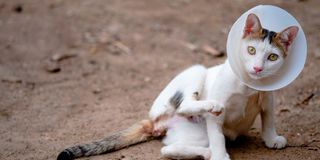Don’t allow your pet to lick its wounds

A cat or a dog will clean any wound from minor irritations like rubs from the harness or other equipment, nails cut too short, fleas and ant bites, scratches and other skin and nail issues.
When a dog or a cat has an injury or anything that is bothering their body, they react by licking the area. They do this to relieve pain, clean the area and soothe themselves.
Pets lick their wounds when they are painful and irritating as an attempt to manage the pain, it is akin to a human rubbing an area of a body that hurts.
Also, if they have incisions that itch as they start to heal, they will lick the area to alleviate the itching. A wound may also be dirty and contaminated with debris, so they sometimes also try to clean that with their tongue.
Minor irritations
A cat or a dog will clean any wound from minor irritations like rubs from the harness or other equipment, nails cut too short, fleas and ant bites, scratches and other skin and nail issues.
You may also see them lick areas where the skin is intact. This could be because the area is hurt or they are experiencing painful joints, fractures, injured muscles or painful bladders. Allergies on food and the environment will have them licking their paws.
How can you tell your dog or cat has been licking their wounds, especially if they only lick themselves when left alone and are unobserved? Look for moistness around the wound or irritated area.
Look for redness, hair loss and irritation as tongues are rough and often pull the surrounding hair out. Friction from the licking will result in redness and irritation in the area.
Brown staining
If the areas they have licked are intact, look for brown staining on the fur. This colouration is usually due to a chemical reaction between the hair and the saliva. The feet and anal area are often affected by staining.
Experts advise that much as it is believed a pet licking their wounds is beneficial and speeds cleaning, it is not a good idea to allow them to lick their wounds.
This is because their mouths get introduced to several bacteria that the saliva cannot kill. They also add more damage to the area by increasing irritation and inflammation. Licking also opens wounds that were previously closed and delays healing.
To prevent your cat from disturbing their wounds, get them cones that act as a barrier to prevent them from reaching the wounded area. Secure it snugly on the neck after cleaning and dressing the wound well.
To prevent licking of extremities, the collar should extend about two inches from the nose. If you do not have a cone, an old t-shirt can work for dogs and baby onesies can work for cats.
Maryanne is a pet owner. [email protected]





